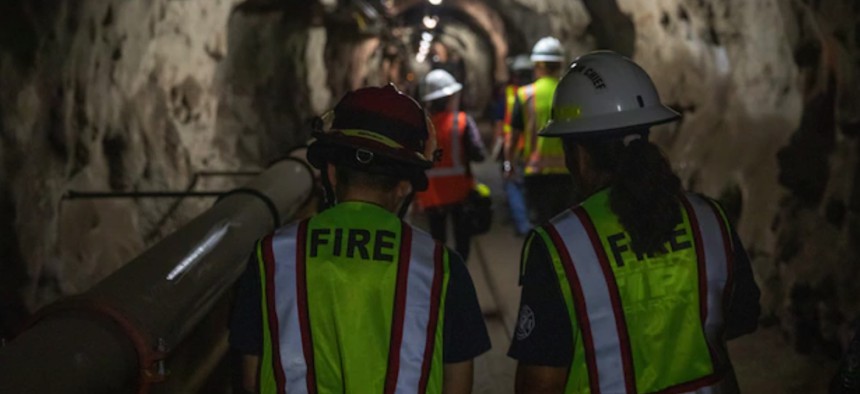
First responders conduct a safety walk-through during Red Hill Bulk Fuel Storage Facility at in Halawa, Hawaii, Oct. 12. U.S. Navy
Hawaiian Families Struggle With Health a Year After a Fuel Leak From an Underground Storage Facility for the Military
A clinic is being established at a local military treatment facility to document symptoms and care for patients.
Hawaiians are struggling with symptoms they attribute to their exposure a year ago to fuel that leaked into their groundwater, and military officials Monday said more needs to be done to help them.
Active-duty troops and their families have been seeking private medical care and reimbursement for it, Rear Adm. John Wade, the commander of Joint Task Force–Red Hill, told reporters. Reservists and civilians, and their families, currently have no way to seek funds for care. Wade said one problem—a “policy gap”—is that the Defense Department has not yet decided who is responsible for providing and funding such care.
The registry of military families who were affected by the fuel leak includes 9,000 families with a total of 16,000 people, according to Adm. Sam Paparo, the commander of U.S. Pacific Fleet based in Hawaii. The admiral’s family is among them, Paparo said Nov. 18 at the 2022 Military Reporters and Editors Association conference. (This reporter is a board member of the association.)
A September survey of 986 people affected by the tainted water found that 80 percent had experienced unusual symptoms in the previous month, including headache, dry or itchy skin, anxiety, fatigue, and difficulty sleeping. The survey was conducted by the Hawaii Department of Health and the Centers for Disease Control and Prevention / Agency for Toxic Substances and Disease Registry.
Red Hill Bulk Fuel Storage Facility is a World War II-era underground fuel storage facility for the military on Oahu that can store up to 250 million gallons of fuel, according to the Environmental Protection Agency.
The facility suffered two fuel leaks in 2021: one on May 6 and the other on November 20. The November incident leaked more than 19,000 gallons of fuel that had been in an aqueous film forming foam retention line from the May leak. Some of it made its way into the local water system, according to the Navy’s command investigation.
In March, Defense Secretary Lloyd Austin decided to close the facility and remove the fuel by June 2024. Earlier this month, Joint Task Force-Red Hill announced it had completed the “unpacking process” of removing fuel from pipelines ahead of the full defueling.
A Red Hill clinic is being established at a local military treatment facility to provide care and document symptoms, Dr. Jennifer Espiritu said at Monday’s briefing. Espiritu is the chief of public health at Tripler Army Medical Center and the interim Defense Health Agency Region Indo-Pacific public health subject matter expert.
“At this point, we are still defining our specifics in terms of our operating hours and days,” she said. “But I can tell you that what it is, is a dedicated clinic for people who are exposed to contaminated water, where they can come in and have access to their own care teams as well as specialists to work up their long-term health concerns.”
The staff will include clinicians from the Army, Air Force, and Navy, and specialists who can address the symptoms people are experiencing, she said, pointing to the CDC survey.
Officials were asked about long-term symptoms and health effects of people exposed to contaminated water. Espiritu said the current medical literature suggests this causes only short-term symptoms, but she added that few studies have looked at long-term exposure. Asked whether there are plans for long-term medical studies of Red Hill cases, she said several have been proposed. In the meantime, the military and other health organizations will be tracking symptoms to then be added to a study.
Espiritu said that people should continue to come forward to describe their symptoms, which may help establish a definitive causal link with the leaked fuel.
“We see patients who have been exposed to fuel in the water, and we see patients who have medical complaints. Those two things are assumed to be true,” she said. “But what we have not found is an association between the two and we've definitely not found a causative association.”
Espiritu agreed that people affected should begin to be monitored, but the health effects they would be looking for, like cancers or neurological problems, could take decades to appear.
“We're branching into new territory,” she said.
In the meantime, Wade still considers that the water “under threat as long as the fuel was above the aquifer.” He said he wants to speed up the defueling timeline as safely as possible, but the plan itself still needs to be approved.







